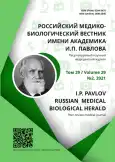Polymorphism of CYP3A4 isoenzyme gene in patients with chronic rheumatic heart disease
- Authors: Petrov V.S.1, Nikiforov A.A.1, Smirnova E.A.1,2
-
Affiliations:
- Ryazan State Medical University
- Ryazan Regional Clinical Cardiology Dispensary
- Issue: Vol 29, No 2 (2021)
- Pages: 239-244
- Section: Original study
- URL: https://bakhtiniada.ru/pavlovj/article/view/65126
- DOI: https://doi.org/10.17816/PAVLOVJ65126
- ID: 65126
Cite item
Abstract
AIM: This study aimed to identify the associations of CYP3A4 isoenzyme gene polymorphism with the parameters of echocardiography (EchoCG), spirometry, and endothelial function of patients with chronic rheumatic heart disease (CRHD).
MATERIALS AND METHODS: A total of 128 patients with CRHD (15.6% men and 84.4% women) were examined. A392A, A392G, and G392G polymorphic markers were genotyped through polymerase chain reaction (PCR) with an SNP-EXPRESS electrophoretic scheme (NPF Litekh, Russia) to detect results after DNA was isolated from leukocytes in venous blood. EchoCG was implemented on an Affinity 50 apparatus (Philips, the Netherlands), endothelial function was assessed with an AngioScan01 apparatus (AngioScan-Electronics, Russia), and respiratory function was examined using a SpiroLab II spirometer (MIR Medical, Italy).
RESULTS: The distance in a 6 min walk test did not show any significant differences among the groups: A392A − 327.47 ± 6.71 m, A392G − 303.63 ± 26.19 m, G392G − 338.87 ± 20.12 m (p=0.505). The area of the mitral opening was as follows: A392A − 1.74 (1.67; 1.81) cm2, A392G − 1.68 (1.45; 1.92) cm2, and G392G − 1.65 (1.67; 1.81) cm2 (p = 0.214). As for the EchoCG parameters, the group of G392G homozygotes had the lowest linear dimensions of the left ventricle (the end diastolic dimension − 4.83 (4.72; 4.95) cm, the end systolic dimension − 2.97 (2.79; 3.14) cm, the right ventricle (2.45 [2.32; 2.58] cm), of the right atrium (4.09 [3.56; 4.62] cm), and the criteria of left ventricular hypertrophy (thickness of the interventricular septum 0.88 [0.81; 0.95] cm, and the posterior wall − 0.88 (0.81; 0.95 cm). No statistically significant differences were found in the occlusion index amplitude among the groups, that is, single nucleotide replacements of CYP3A4 had no influence on the system of low-resistance arteries. Conversely, the values of the phase shift between channels (reflecting the condition of large arteries) significantly differed. The G392G polymorphism showed the worst parameters, and minimal changes were observed in the A392A group. Contour analysis demonstrated the highest augmentation index values in the G392G group, reflecting the maximal stiffness of vessels. The CYP3A4 polymorphism had no effect on the parameters of respiratory function in the studied cohort of patients. Spirometry revealed that the obstructive and restrictive parameters were not significant although homozygotes demonstrated the highest forced vital capacity of the lungs (76.5% [71.1% and 82.0%]) and forced expiratory volume for 1 s (84.6% [79.0% and 90.3%]). The maximal parameter of the vital capacity of the lungs in homozygotes for A392A (85.6% [82.3% and 88.8%]).
CONCLUSION: Patients with CRHD homozygous for G392G had the minimum parameters of hypertrophy and dimensions of the left ventricular cavity. They also had the lowest values for the cavities of the right heart. CYP3A4 polymorphism had no effect on the parameters of respiratory function in the studied patients with CRHD.
Full Text
##article.viewOnOriginalSite##About the authors
Vadim S. Petrov
Ryazan State Medical University
Author for correspondence.
Email: dr.vspetrov@gmail.com
ORCID iD: 0000-0001-8631-8826
SPIN-code: 4553-3581
MD, Dr.Sci.(Med.), Associate Professor of the Hospital Therapy Department with Medical and Social Expertise Course
Russian Federation, RyazanAlexander A. Nikiforov
Ryazan State Medical University
Email: a.nikiforov@rzgmu.ru
ORCID iD: 0000-0002-7364-7687
SPIN-code: 8366-5282
MD, Cand.Sci.(Med.), Head of the Central Research Laboratory
Russian Federation, RyazanElena A. Smirnova
Ryazan State Medical University; Ryazan Regional Clinical Cardiology Dispensary
Email: Smirnova-EA@inbox.ru
ORCID iD: 0000-0003-0334-6237
SPIN-code: 6503-8046
ResearcherId: Y-1235-2018
MD, Dr.Sci.(Med.), Associate Professor of the Hospital Therapy Department with the Course of Medical and Social Expertise
Russian Federation, Ryazan; RyazanReferences
- Sychev DA, Otdelenov VA, Denisenko NP, et al. The study of the activity of isoenzymes of cytochrome p450 for the prediction of drug-drug interactions of medicines in terms of polypharmacy. Pharmacogenetics and Pharmacogenomics. 2016;(2):4-11. (In Russ).
- Mirzaev KB, Fedorinov DS, Ivashchenko DV, et al. Multi-Ethnic Analysis of Cardiac Pharmacogenetic Markers of Cytochrome P450 and Membrane Transporters Genes in the Russian Population. Rational Pharmacotherapy in Cardiology. 2019;15(3):393-406. (In Russ). doi: 10.20996/1819-6446-2019-15-3-393-406
- Williams JA, Hyland R, Jones BC, et al. Drug-drug interactions for UDP-glucuronosyltransferase substrates: a pharmacokinetic explanation for typically observed low exposure (AUCi/AUC) ratios. Drug Metabolism and Disposition. 2004;32(11):1201-8. doi: 10.1124/dmd.104.000794
- Katoh M, Nakajima M, Yamazaki H, et al. Inhibitory potencies of 1,4-dihydropyridine calcium antagonists to P-glycoprotein-mediated transport: comparison with the effects on CYP3A4. Pharmaceutical Research. 2000;17(10):1189-97. doi: 10.1023/a:1007568811691
- Corsini A, Bellosta S, Baetta R, et al. New insights into the pharmacodynamic and pharmacokinetic properties of statins. Pharmacology & Therapeutics. 1999;84(3):413-28. doi: 10.1016/s0163-7258(99)00045-5
- Kaminsky LS, Zhang ZY. Human P450 metabolism of warfarin. Pharmacology & Therapeutics. 1997;73(1):67-74. doi: 10.1016/s0163-7258(96)00140-4
- Heidbuchel H, Verhamme P, Alings M, et al. European Heart Rhythm Association. European Heart Rhythm Association Practical Guide on the use of new oral anticoagulants in patients with non-valvular atrial fibrillation. Europace. 2013;15(5):625-51. doi: 10.1093/europace/eut083
- Berstneva SV, Shakhanov AV, Yankina SV. Genes coding for components of renin-angiotensin system and factors of endothelium and their role in development of diabetic nephropathy in type 2 diabetes mellitus. Nauka Molodykh (Eruditio Juvenium). 2018;6(3):420-8. (In Russ). doi: 10.23888/HMJ201863420-428
- Shakhanov AV, Nikiforov AA, Uryasyev OM. Polymorphism of nitric oxide synthase genes (NOS1 84G/A and NOS3 786C/T) in patients with bronchial asthma and essential hypertension. I.P. Pavlov Russian Medical Biological Herald. 2017;25(3):378-90. (In Russ). doi: 10.23888/PAVLOVJ20173378-390
Supplementary files






